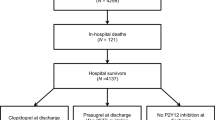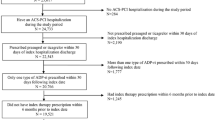Abstract
Background: The PCI-CURE (Percutaneous Coronary Intervention-Clopidogrel in Unstable Angina to Prevent Recurrent Events) and CREDO (Clopidogrel for the Reduction of Events During Observation) studies have demonstrated that, in addition to aspirin, pre-treatment with clopidogrel followed by long-term (i.e. 9—12 months) therapy significantly reduces the risk of atherothrombotic events in patients undergoing percutaneous coronary intervention (PCI).
Objective: To examine the economic implications, from the Dutch healthcare perspective, of the use of clopidogrel in patients undergoing PCI (elective procedures or in patients with acute coronary syndrome), comparing pre-treatment followed by long-term therapy with only 4 weeks of treatment.
Methods: A lifetime Markov model was used to combine data from the PCI-CURE and CREDO trials with data from the literature concerning epidemiology, costs and quality of life. The model was run separately for each trial. Only direct healthcare costs (€, year 2004 values) were considered. Costs and outcomes were discounted at 4% per anum.
For each trial, the cost effectiveness is expressed as costs per life-year and QALY gained. Uncertainties are addressed by uni- and probabilistic multivariate sensitivity analysis.
Results: When starting with the data from the PCI-CURE trial, pre-treatment plus 9-month clopidogrel therapy was predicted to save €1119 and gain 0.03 life-years and 0.07 QALYs per patient compared with short-term treatment. When starting with the data from the CREDO trial, the combination of pre-treatment and prolonged clopidogrel therapy (1 year) was estimated to save €497 and gain 0.10 life-years and 0.14 QALYs per patient. Univariate and probabilistic multivariate sensitivity analyses suggested that the conclusions were generally robust, but that the expected gain in survival for the PCI-CURE population was very sensitive to the effects on mortality within the combined endpoint of myocardial infarction/stroke-free survival.
Conclusions: In The Netherlands, pre-treatment plus long-term (9–12 months) therapy with clopidogrel is estimated to save costs and increase (quality-adjusted) survival in the prevention of ischaemic events among patients undergoing elective PCI (CREDO) and in patients with acute coronary syndrome (PCI-CURE) compared with short-term treatment with clopidogrel without pre-treatment.










Similar content being viewed by others
References
Mehta S, Yusuf S, Peters R, et al. Effects of pretreatment with clopidogrel and aspirin followed by long-term therapy in patients undergoing percutaneous coronary intervention: the PCI-CURE study. Lancet 2001; 358: 527–533
Steinhubl S, Berger P, Mann J III, et al. Early sustained dual oral antiplatelet therapy following percutaneous coronary intervention. JAMA 2002; 288: 2411–2420
The Dutch Institute for Healthcare Improvement (CBO). Multi disciplinary guideline cardiovascular risk management. Utrecht: The Dutch Institute for Healthcare Improvement (CBO), 2006
The Dutch Institute for Healthcare Improvement (CBO). Treatment and prevention of coronary heart disease by lowering plasma cholesterol levels. Utrecht: The Dutch Institute for Healthcare Improvement (CBO), 1998
Task force Revised guidelines Hypertension. Revised guidelines hypertension. Utrecht: The Dutch Institute for Healthcare Improvement (CBO), 2000
Sonnenberg F, Beck J. Markov models in medical decision making: a practical guide. Med Decis Making 1993; 13: 322–339
Heeg BMS, van Gestel A, van Hout BA, et al. Costs and effects of clopidogrel versus aspirin in high-risk acute coronary syndrome patients in Denmark. Ugeskrift for Lager 2006; 168: 2911–2915
College voor Zorgverzekeringen. Dutch guidelines for pharmacoeconomic research. Amstelveen: College voor Zorgverzekeringen, 1999
Central Bureau of Statistics. Statline [online]. Available from URL: www.CBS.nl [Accessced 2007 Aug 9]
Peeters A, Mamun A, Willekens F, et al. A life course analysis of the original Framingham heart study cohort. Eur Heart J 2002; 23: 458–466
Hollander D, Koudstraal P, Bots M, et al. Incidence, risk, and case fatality of first ever stroke in the elderly population: the Rotterdam Study. J Neurol Neurosurg Psychiatry 2003; 74: 317–321
Koek HL, de BA, Gast F, et al. Short- and long-term prognosis after acute myocardial infarction in men versus women. Am J Cardiol 2006 Oct 15; 98 (8): 993–999
The Clopidogrel in Unstable Angina to Prevent Recurrent Events trial investigators. Effects of clopidogrel in addition to aspirin in patients with acute coronary syndromes without ST-segment elevation. N Engl J Med 2001; 345: 494–502
CAPRIE Steering Committee. A randomised, blinded, trial of clopidogrel versus aspirin in patients at risk of ischaemic events (CAPRIE). Lancet 1996; 348: 1329–1339
Caro J, Migliaccio-Walle K, for the CAPRA study group. Generalizing the results of clinical trials to actual practice: the example of clopidogrel therapy for the prevention of vascular events. Am J Med 1999; 107: 568–572
de Boer MJ, Lee Liem A, Suryapranata H, et al. A cost-effective analysis of primary coronary angioplasty versus thrombolysis for acute myocardial infarction. Am J Cardiol 1995; 76: 830–833
Niessen LW, Dippel DW, Limburg M. Calculation of costs of stroke, cost effectiveness of stroke units and secondary prevention in patients after a stroke, as recommended by revised CBO practice guideline’ Stroke’. Ned Tijdschr Geneeskd 2000; 144: 1959–1964
Serruys PW, van Hout B, Bonnier H, et al. Randomised comparison of implantation of heparin-coated stents with balloon angioplasty in selected patients with coronary artery disease (Benestent II). Lancet 1998; 352: 673–681
College voor Zorgverzekeringen. Farmacotherapeutisch Kompas 2004. Amstelveen: CVZ, 2004
Hiatt MD. Thrombolytic therapy with streptokinase and tissue plasminogen activator in a patient with suspected acute myocardiol infarction: a decision analysis. Cardiology 1999; 91: 243–249
Tsevat J, Goldman L, Soukup JR, et al. Stability of time-tradeoff utilities in survivors of myocardial infarction. Med Decis Making 1993; 13: 161–165
Mark D, Hlatky M, Califf R, et al. Cost effectiveness of thrombolytic therapy with tissue plasminogen activator as compared with streptokinase for acute myocardial infarction. N Engl J Med 1995; 332: 1418–1424
Lee TT, Solomon N, Heidenreich PA, et al. Cost-effectiveness of screening for carotid stenosis in asymptomatic persons. Ann Intern Med 1997; 126: 337–346
Hallan S, Asberg A, Indredavik B, et al. Quality of life after cerebrovascular stroke: a systematic study of patients’ preferences for different functional outcomes. J Intern Med 1999; 246: 309–316
Prismant. Hospital statistics [online]. Available from URL: www.prismant.nl [Accessed 2007 Aug 9]
Doubilet P, Begg C, Weinstein M, et al. Probabilistic senstivity analyses using Monte Carlo simulation: a practical approach. Med Decis Making 1985; 5: 157–177
van Hout BA, Al MJ, Gordon GS, et al. Costs, effects and C/E-ratios alongside a clinical trial. Health Econ 1994; 3: 309–319
Eriksson P. Long-term clopidogrel therapy after percutaneous coronary intervention in PCI-CURE and CREDO: the “Emperor’s New Clothes” revisited. Eur Heart J 2004; 25: 720–722
van Luijn JCF Farmacoeconomic report clopidogrel (Plavix). Amstelveen: Dutch Healthcare Insurance board, 2004
van Hout BA, Tangelder M, Bervouts P, et al. Cost-effectiveness analysis of clopidogrel in acute coronary syndromes without ST-segment elevation in the Netherlands [abstract]. Value Health 2003; 6: 667
Lindgren P, Jonsson B, Yusuf S. Cost-effectiveness of clopidogrel in acute coronary syndromes in Sweden: a long-term model based on the CURE trial. J Int Med 2004; 255: 562–570
Annemans L, Lindgren P, Frei A, et al. Cost-effectiveness analysis of clopidogrel in patients with unstable coronary artery disease undergoing percutaneous coronary interventions: a five European countries analysis [abstract]. Eur Heart J 2003; 24: Suppl.: 130
Lindgren P, Stenestrand U, Malmberg K, et al. The long-term cost-effectiveness of clopidogrel plus aspirin in patients undergoing percutaneous coronary intervention in Sweden. Clin Ther 2005; 27: 100–110
Weintraub WS, Mahoney EM, Mehta S, et al. Long-term cost-effectiveness of clopidogrel in patients having percutaneous coronary intervention early after acute coronary syndrome: results from PCI-CURE [abstract 1137-77]. J Am Coll Cardiol 2004; 43 Suppl. 2: A296
Cowper P, Udayakumar K, Sketch M, et al. Economic effects of prolonged clopidogrel therapy after percutaneous coronary intervention. J Am Coll Cardiol 2005; 45: 369–376
Ringborg A, Lindgren P, Jonsson B. The cost-effectiveness of dual oral antiplatelet therapy following percutaneous coronary intervention: a Swedish analysis of the CREDO trial. Eur J Health Econ 2005 Dec; 6 (4): 354–362
Iakovou I, Schmidt T, Bonizzoni E et al. Incidence, predictor, and outcome of thrombosis after successful implantation of drug-eluting stents. JAMA 2005; 4: 2126–2130
Acknowledgements
The authors would like to acknowledge Frank de Charro and Maarten Treur for their help during the preparation of this paper. The article was supported by a grant from Sanofi-Aventis, The Netherlands. The authors maintained control of all analyses and the content of this manuscript.
Bart Heeg is employed by, and Marc Botteman and Ben van Hout are partners of, Pharmerit. Pharmerit has contracts with Sanofi-Aventis. Ron Peters and Ben van Hout have received consultancy fees and honoraria from Sanofi-Aventis.
Author information
Authors and Affiliations
Corresponding author
Electronic supplementary material
Rights and permissions
About this article
Cite this article
Heeg, B.M.S., Peters, R.J.G., Botteman, M. et al. Long-Term Clopidogrel Therapy in Patients Receiving Percutaneous Coronary Intervention. Pharmacoeconomics 25, 769–782 (2007). https://doi.org/10.2165/00019053-200725090-00005
Published:
Issue Date:
DOI: https://doi.org/10.2165/00019053-200725090-00005




